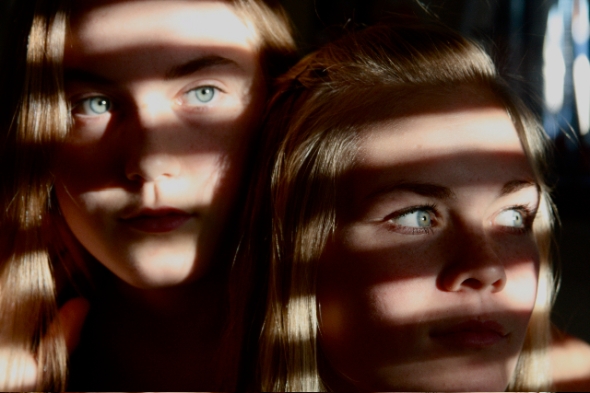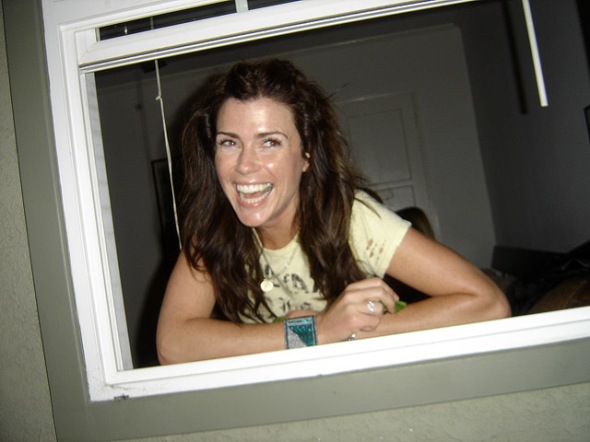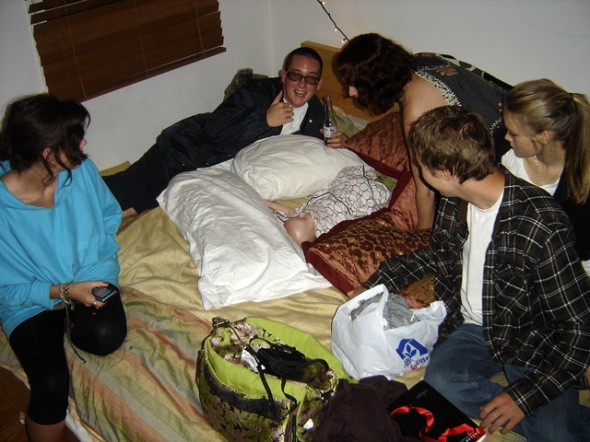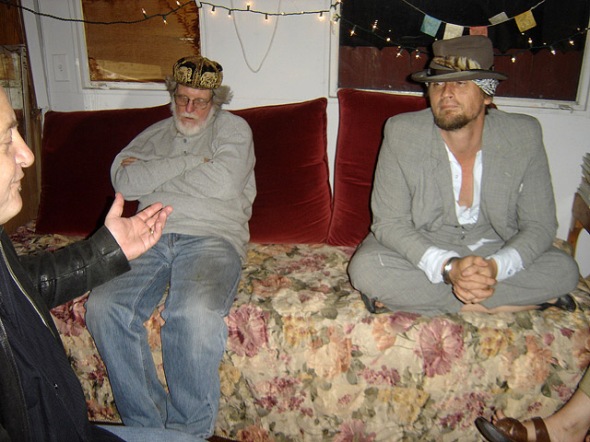Posted: March 9, 2012 | Author: Venice Arts Club | Filed under: AT SUNSET, Doug Lewis, Jim Budman, Mark Baer, Mark Brooks | Tags: at sunset club, doug lewis, jamie cohen, jim budman, mark brooks, sunset strip |
Sunset Stripped is a cautionary tale concerning sexual obsession, blackmail, and murder. It’s the roaring ’80s, a time of greed, cocaine, and Iran-Contra. Narcissism is the fashion, AIDS is the new reality, and Ronald Reagan is snoozing at the wheel.
DESCRIPTION OF SUNSET STRIPPED : Willie Talburt, a talented but down-and-out screenwriter, thinks his luck is changing when he snatches $300 off a drunk’s shoes at a legendary West Hollywood bistro and then meets exotic Veronica Blainewell. He would do anything to see his name on one of the giant billboards that loom high over the Sunset Strip, and she offers him the chance. But the deal and the dame don’t turn out to be as sweet as Willie’s dreams.
VENICE ARTS CLUB INTERVIEW WITH MARK BAER:
VAC: When where you writing Sunset Stripped?
M.D. BAER: Pretty much as it was happening. During and after the dust settled.
VAC: Sounds chaotic, Los Angeles in the roaring 80’s. Describe the setting?
M.D.BAER: For me, it began with Reagan and with Mr. Dougie (Doug Lewis) arriving in Los Angeles and meeting Jim Budman. I was living with my wife at the time, jewelry designer Ezmarelda Gordon, at the estate of Bettina Bancroft in Bel Air, at 191 North Bentley. The estate belonged to Natalie Wood and Robert Wagner until she died. On a vacation to Tahiti, Bettina’s daughter, Elisabeth, met Mr. Dougie who at that time was working and living as a fisherman in Australia and the South Pacific. The two of them became an item, he became friends with the family and when he visited Elisabeth and her family in L.A., he ended up moving in and staying a while. Even then, Bentley was quite a scene, anyone who was there would tell you, but after Mr. Dougie met Jim Budman, who along with Mark Brooks, Dan Millington, Adam Linter, Dana McDonald and Diane Bald launched AT SUNSET, everything went into overdrive, a real happening. AT Sunset became the place to be in L.A., it’s what people looked forward to, heading into Hollywood and going to AT Sunset, often until dawn. It was the rich, the famous, the unknown, young and old, gay and straight, a real mix, enough to make the head spin. For a writer, it was rich ground.
VAC: So, in the novel, the ‘Duck Club Crew’ is really based on the AT Sunset scene?
M.D. BAER: Loosely…we’re dealing with fiction here…


AT SUNSET 1982. L TO R: Dan Millington, Doug Lewis, Mark Baer, Mark Brooks, unknown.

Posted: February 29, 2012 | Author: Venice Arts Club | Filed under: Andy Kravitz, Arthur Barrow, AT SUNSET, Cara Tompkins, Doug Lewis, Fell Music, James Mathers, Jim Budman, Kristen Vigard, Mark Brooks | Tags: adam linter, arthur barrow, at sunset, buster keaton, dan millington, diana ross, doug lewis, fell music, greta garbo, james mathers, jamie cohen, janet jackson, jim budman, joan crawford, joe cocker, kristen vigard, larry klimas, lotek studios, mark brooks, michael budman, nina hagen, robby krieger, sunset strip, the doors, tom brechtlein, tommy mars, venice CA, vinnie colaiuta, warren cucurullo, zappa |
TIDE GOES IN, TIDE GOES OUT was written by Doug Lewis, performed by Kristen Vigard and recorded by Fell Music at Lotek Studios, Mar Vista, CA.
LOTEK STUDIOS
Lotek Studios is owned and operated by ex-Zappa bass player, ‘Clonemeister’, and music legend, Arthur Barrow, and is a mecca for L.A. recording artists seeking quality sound production engineered and produced in the lo-key, no rush, uber-eclectic environment of Barrow’s spaceship he calls Lotek Studios.
Lotek began life as a classic Los Angeles bungalow/cottage. Located south of downtown Los Angeles, the bungalow was trailered away to make room for the landing of the then new L.A. Coliseum. Barrow launched his studio in 1983. Eclectic is a fitting description for Lotek studios. Even the arrival is offbeat – via an unpaved Mar Vista/Venice back alley through a pleasantly overgrown compound and up a back porch to the studio then into the control room. Barrow will offer you coffee, ask you to smoke outside, fire up the master switch and get down to the business of making music.
Barrow’s skills as a multi-instrumentalist musician, engineer, programmer and producer are evident by a glance at his catalogue. Zappa, The Doors, Robby Kreiger, Berlin, Joe Cocker, Diana Ross, Nina Hagen, Janet Jackson, Oingo Boingo, Billy Idol, Giorgio Moroder. Some of his many film credits include work on Top Gun, Scarface, The Doors, Breakfast Club. Barrow also composes music for classic silent films, including: The Cameraman with Buster Keaton, The Torrent featuring Greta Garbo, and The Boob, starring Joan Crawford. His self-published albums feature rich, complex and melodic compositions with a sound perfectly tailored to the Now.
If you’re a musician, an invitation to one of Arthur’s jams can be hard to come by. His guest list is an elite mix, usually Tommy Mars on Hammond organ, Rhodes piano, Rogers synth and vocals. Then there’s either Vinnie Colaiuta, Tom Brechtlein or Andy Kravitz on drums. Brass includes Larry Klimas with Bruce and Walt Fowler. On guitar is Robby Krieger or Warren Cucurullo, while Barrow handles bass. The several incarnations born out of these collaborations include Banned From Utopia, The Mar Vista Philharmonic, Theoretical 5.
KRISTEN VIGARD
The music hardly rests in Kristen Vigard. She’s always bopping and singing, talking a profound stream, reciting and recalling fact and fiction in a dizzy blur, tapping a beat, restoring order or creating chaos, sometimes all at once and usually in double speed.
As a child performer, Kristen was on Broadway in the original production of ‘Annie’. In her teens and twenties, Kristen played Moran Richards on the popular daytime soap, The Guiding Light. Then there was a calling and a move to Paris to sing in clubs and busk the streets. New York was next, then Los Angeles to record her first album, backed by Jamie Cohen at Private Music.
Kristen first met Doug Lewis of Fell Music in 1982, at the L.A. happening, AT SUNSET. Located on the Sunset Strip at 8907 Sunset Blvd., Lewis was one of six core members At Sunset, an idea launched by media artist Jim Budman to, by word of mouth, “open the (back) door and see what happens”. What happened was that word spread, virally speaking, from the six members (Budman, Lewis, Mark Brooks, Dan Millington, Adam Linter and Dana McDonald) and out into an ever-expanding network. The result, in short time, was the evolution to a ‘multi-functional, omni-sexual, relatively civilized space where anything could, and usually did happen’.
Kristen Vigard became a regular At Sunset, her crowd included Basquiat and Warhol, James Mathers and the Topanga Scene, John Frusciante and Anthony Kleidas of the newly formed Chili Peppers.
AT SUNSET 1981-84
At Sunset occupied the former Sneaky Pete’s restaurant, a former hipster hangout on the Sunset Strip. The policy was backdoor only, down a long series of steps which adjoined and shared a common wall with the Whiskey A-Go-Go. Once at the door, if you were either on the guest list or were invited in, you paid a twenty dollar ‘donation’. Once in, there were no rules, so to speak, but especially in terms of the interior space – all was accessible.
Budman’s brother, Michael, owner of Roots sportswear, was living in Paris and had begun a monthly fashion/culture magazine called ‘Passion’, published in English for international distribution. After an ad was placed for At Sunset featuring only the logo (a John Van Hammersfeld litho) and address, word got out and the celebs arrived.
The surreal aspect of At Sunset was apparent inside through the actions of those guests who realized the loose aspect of the environment. You could walk into and through the kitchen, into the walk-in cold-box. Or you could walk behind the bar and serve beer, wine and sake to fellow patrons. A large adjacent room served as the dance floor/stage area, then up a set of steps to two more private rooms, where interviews would be filmed, lines could be drawn, lights could be dimmed…
Outside on the Sunset Strip an equally dynamic scene was in full swing – Punks, Mods, Rockers, Funksters and Ska’s mixed with Hollywood translife at the corner of Sunset and San Vicente. At Sunset added the gay and the straight, the young and the old, the Valley, Downtown, Malibu, Venice, and the celebs. On any given late night would be Tim Leary or Truman Capote or George Carlin behind the bar slinging drinks to a crowd rocking to a DJ spinning Tainted Love by Soft Cell, or The Untouchables in the next room spreading the live vibe.
In late 1984, exhausted by three years of nightlife, Budman, Lewis and the rest of the At Sunset crew closed the doors and the party was over.
VENICE
A decade later, Jamie Cohen was riding his bike near his house on Electric Ave. in Venice when he spotted Doug Lewis walking his dog. Turns out they lived a block from each other. Jamie Cohen was a legendary A&R man, who had signed Kristen to her first recording contract. Cohen also played a key early role At Sunset, setting up and spinning records for the dance crowd, and bringing in the music industry alumni, including Clive Davis.
It was Cohen who introduced Lewis to Arthur Barrow, which in turn led to the production of Fell Music, featuring Lewis, Cohen, Kristen Vigard, Robert Williams, Barrow, and others. The seven albums that make up Fell Music were recorded at Lotek Studios from 1994-2006.
TIDE GOES IN, TIDE GOES OUT
Tide Goes In, Tide Goes Out is written by Doug Lewis and performed by Kristen Vigard. The spanish guitar was added by Jorge, a player Cohen and Lewis found at La Cabana, a popular Venice eatery. Other musical performers include Lewis on guitar, Arthur Barrow on bass, guitar and organ, Robert Williams on drums. Mastered by Bob Stone RIP. The song was originally released on Fell Music, Volume 6, titled ‘The New Dystopia’. It is currently available from the Fell Music Bandcamp site, on The Best of Fell Music, Volume 1.
*
The Serge @ Lotek Studios. Image/Cara Tompkins

Lotek Studios & Tommy Mars. Image/Cara Tompkins

Doug Lewis at the Lotek board. Image/Cara Tompkins

At Sunset, Details Magazine

Doug Lewis

Jamie Cohen

Kristen Vigard
















